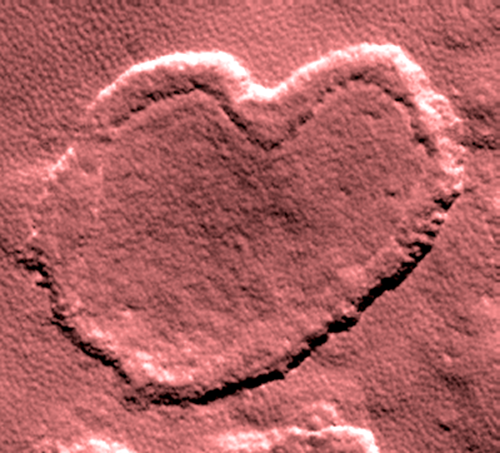Antennae Galaxies
Antennae Galaxies are two merging pair of galaxies(NGC 4038 and NGC 4039). These were discovered by William Herschel in 1785. Antennae Galaxies are located in Corvus constellation some 60 million light-years away.
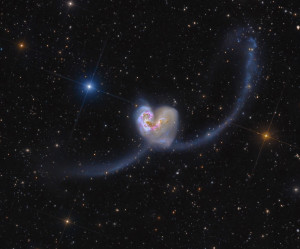 Image by R.W. Olsen and Processing by Federico Pelliccia and Rolf Wahl Olsen
Image by R.W. Olsen and Processing by Federico Pelliccia and Rolf Wahl Olsen
These two galaxies already started to merge a few hundred million years ago. This is youngest and newarest example of colliding galaxies. During this collision, billions of stars will be formed in super star clusters. Nearly half of the faint objects Antennae image are young clusters. The orange colored regions are cores of these galaxies which contain mainly old stars. The nuclei of the two galaxies are joining to become one giant galaxy. This is a preview of what may happen when our Milky Way galaxy As two humans comes together with Valentine the outcome of this is a marriage is similar similar in case of Antennae Galaxies!
The Heart Nebula
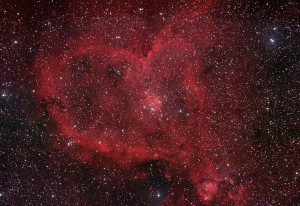 The Heart Nebula (IC 1805) located in the Perseus Arm of the Galaxy in the constellation Cassiopeia. This is 7500 light years away from Earth. This is an emission nebula showing glowing gas and darker dust lanes. The nebula is formed by plasma of ionized hydrogen and free electrons. The nebula’s intense red output and its configuration are driven by the radiation emanating from a small group of stars near the nebula’s center. This open cluster of stars known as Melotte 15 contains a few bright stars nearly 50 times the mass of our Sun. This also contains many more faint stars that are only a fraction of our Sun’s mass. The cluster used to contain a microquasar that was expelled millions of years ago.
The Heart Nebula (IC 1805) located in the Perseus Arm of the Galaxy in the constellation Cassiopeia. This is 7500 light years away from Earth. This is an emission nebula showing glowing gas and darker dust lanes. The nebula is formed by plasma of ionized hydrogen and free electrons. The nebula’s intense red output and its configuration are driven by the radiation emanating from a small group of stars near the nebula’s center. This open cluster of stars known as Melotte 15 contains a few bright stars nearly 50 times the mass of our Sun. This also contains many more faint stars that are only a fraction of our Sun’s mass. The cluster used to contain a microquasar that was expelled millions of years ago.
This is perfect Valentine Shaped Nebula.
Mars Valentine Craters
This Mars Valentine Crater is heart-shaped feature found in Arabia Terra on Mars which was taken by the Context Camera (Mars Reconnaissance Orbiter) on May 23, 2010. A small impact crater near the tip of the heart is responsible for the formation of the bright, heart-shaped feature. The heart-shaped feature is about 1 kilometer long in Arabia Terra region of northern hemisphere.
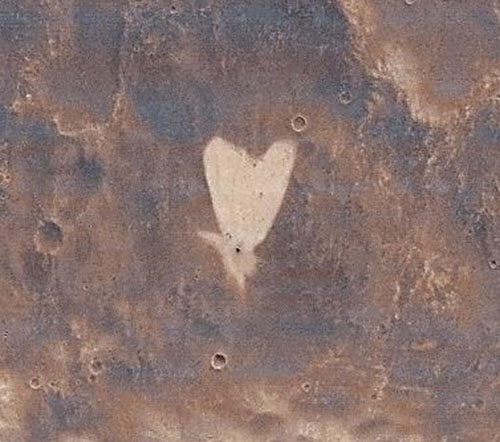
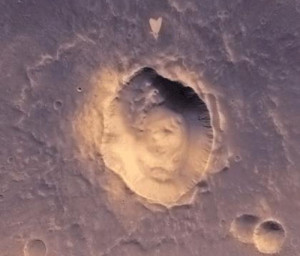
This looks perfect Heart shape and this picture taken by Mars Global Surveyor (MGS). This valentine from Mars is actually a pit formed by collapse within a straight-walled and it is known in geological terms as a graben. This heart-shaped pit is about 2.3 kilometers at wide. The graben, pit, and lava flow are located on the east flank of the Alba Patera volcano in northern Tharsis.

